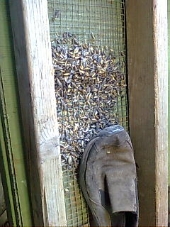Hi guys!
It's been a year, I wanted to give an update on what I've learned about it, in case it helps others.
Summary:
1. Bending and heterogeneity actually were a problem for processing
2. Causes were likely all three reasons in my case: excess fertilizer, too high sowing density and lack of sunlight
Bending and heterogeneity were a problem
It turned out that the yield seemed ok last year.
However, the fact that plants were bending over, and of heterogenous sizes made the whole harvesting - threshing - winnowing process difficult.
Harvesting was not that bad. It was slower, but overall not a big deal.
Threshing was the most problematic part. Because cut stems were not all pointed in the same direction, and not of the same lengths, I could neither whack them over a board, nor beat just the heads. I was stuck with a messy mixture of straw and heads without any order.
Winnowing was made harder too, because the result of the threshing process contained a lot more straw.
Additionally, this year I realized that bending also decreased the yield, probably because some animals ate on the heads, probably rodents. I had entire square meters without any heads left.
Causes were threefold in my case
I can tell now because I've grown again this year, but I changed two things :
1. This year I didn't add any fertilizer, so it only used last year's manure
2. This year I sowed in furrows, one seed every 10 cm (4 inches)
I had read that actually, sowing too densely could also lead to long stems, and thus bending. It makes sense. The way I interpret it, is that if plants are too close to each other, they suffer more competition, they don't tiller, and they try to grow higher, to get sunlight. Conversely, if they have enough space, they tiller and don't need to go as high.
The result this year: my plants tillered, which was the first time for me. At first they were pretty straight, but after a few months some of them started bending. And that's when I could add the sunlight cause: the parts that were in full sunlight stayed straight, the parts that were in the shade in the afternoons bent over.
Since last year, every plants were bending, I can tell that sunlight was not the only issue in my case. Because this year only parts of it are bending seems to mean that I solved the fertilizer and spacing part, an that sunlight is also an issue.
I hope this helps someone else in the future.
I am still interested to read your thoughts if this resonates with what you know, if you confirm or have another opinion.
Cheers!










